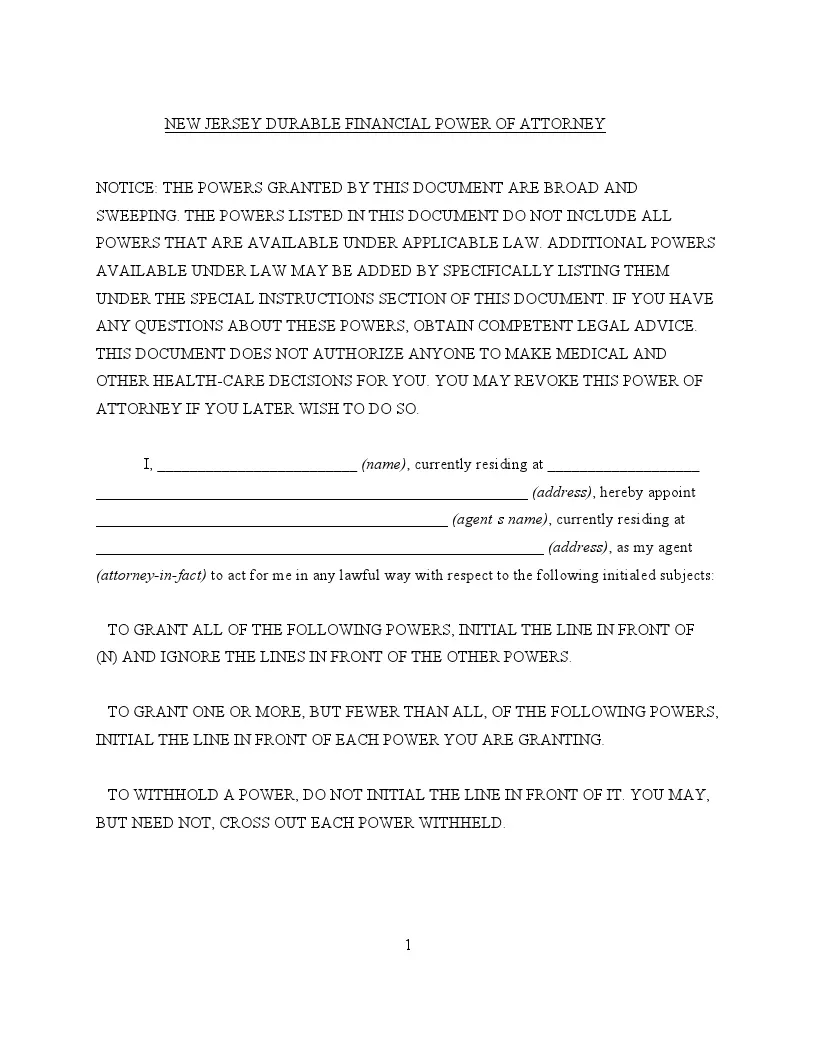Free New Jersey Durable Power of Attorney Form
If someone suddenly becomes unable to manage his or her finances, a special form called “Durable Power of Attorney” (or DPA) helps to clarify the responsible agent or attorney that has the right to act on behalf of the person (or principal). So, in the US, you need to prepare the DPA form to protect your properties and finances in case of a severe illness or accident that may lead you to a critical condition (a stroke, coma, or similar) that makes you unavailable.
By this form, you may delegate all the financial matters to someone you trust, and he or she will conduct until your death if you are unable to deal with several things. This is why the form is “durable”: it is effective until the moment you die. Another way to cancel the form is to revoke it.
Creating and signing a durable power of attorney form is strongly tied to choosing a person you trust who will have the power to deal with the various operations and transactions related to the money. There are two options that you have while choosing this person: either hiring a professional agent or designating a member of your family.
New Jersey power of attorney forms – learn more about powers of attorney for other assets in the State of New Jersey.

Build Your Document
Answer a few simple questions to make your document in minutes
Save and Print
Save progress and finish on any device, download and print anytime
Sign and Use
Your valid, lawyer-approved document is ready
In the US, the rules of the DPA form completion change from state to state. Usually, this paper has to be notarized or approved by a witness (two witnesses in some states). Signatories should be in good conscience while accepting and signing the form.
You should also know that the DPA form will not state any of your health or medical care orders. To appoint a representative for such orders, you should proceed to another form.
New Jersey Signing Requires and Laws
As sections of New Jersey state law 46:2B-8.9 and 46:14-2.1 say, the DPA form in this state requires a witness and a notary to sign.
The DPA form in New Jersey allows a principal to assign a lot of responsibilities to his or her attorney or agent. The list covers the majority of possible operations related to finances. It includes:
- Business-related operations
- Taxes
- Real estate transactions and operations
- Retirement plan operations
And plenty of other actions that one may delegate to another. You may either choose all or opt for a limited number of them.
The DPA form is a vital document that imposes a huge responsibility on the agent or attorney and protects your finances. So, do not rush to complete the form. Read all the statements carefully and think about whether you would like to hire an agent or choose an attorney among your family members or closest people.
Do not forget to print three copies of the DPA form as recommended in most of the states. In New Jersey, the document is quite brief and consists of six pages.
New Jersey Durable Power of Attorney Form Details
| Document Name | New Jersey Durable Power of Attorney Form |
| Other Names | New Jersey Financial Durable Power of Attorney, NJ DPOA |
| Relevant Laws | New Jersey Statutes, Sections 46:2B-8.1 to 46:2B-10 |
| Signing Requirements | Notary Public and One Witness |
| Avg. Time to Fill Out | 10 minutes |
| # of Fillable Fields | 37 |
| Available Formats | Adobe PDF |
Popular Local Durable POA Forms
Durable POA templates are some of the most commonly used ones within the US. The following are some of the more asked durable power of attorney documents.
Steps to Complete the Form
For your convenience, we have prepared detailed instructions about the DPA form creating in New Jersey. You may check out the steps to create this document below.
1. Download the New Jersey DPA Form Template
To create the DPA form in New Jersey, you have to download the template. Use our form-building software that will help to speed the whole process up.
2. Read the Notice Thoroughly
The DPA form in New Jersey starts with a notice that every signatory has to read. This notice explains the basic details that he or she has to know before finishing to complete the form and signing it.
Read the text carefully. If something stays unclear, ask your lawyer to ensure your understanding.
3. Complete the Paragraph with Your Details and Your Agent’s Details
Under the notice, the form has a paragraph where you, as a principal, should place your full name and address. Also, your attorney or agent’s full name and address are needed further.

4. Choose Responsibilities for Your Agent
Here, you will meet the list of all the responsibilities regarding financial matters that you can assign to your attorney or agent. In New Jersey, the full list in the DPA form includes:
- Banking and other financial institutions operations
- Real estate operations
- Commodity and option operations
- Stocks and bonds
- Claims and litigation
- Retirement plan operations
- Family and personal maintenance
- Taxes
- Insurance matters
- Governmental benefits and programs
- Estate, trust, and other beneficiary operations
- Tangible personal property operations
- Business operations
The last option to choose is “all of the powers.” If you want to designate all of them, put your initials here. When opting for separate powers, place initials to every point of the list.

5. Add Special Instructions (If Applicable)
Below the powers that you may delegate, you can see the blank lines where a principal may place special instructions for his or her attorney or agent. In these lines, you may limit or increase the degree to which your agent will have powers.

6. Insert the Successor Agent Details
In New Jersey, you may add the name of your successor agent to the DPA form. A successor agent is a person that will act instead of your agent or attorney if one is unavailable or has died. A principal can add more than one approved successor agent in the document.

7. Sign the Form
As a principal, you will need to put your signature after reading and understanding all the conditions stated in the form. Unlike the forms in other states, the DPA form in New Jersey has a blank line for the principal’s Social Security Number (SSN). Also, in this section, you have to insert the relevant date.

8. Ask Notary to Sign
Below the lines where you had put your signature and signing date, you will see a section for a notary’s signature and seal. The notary should complete this section.

9. Ask Your Attorney or Agent to Sign
Here, your agent or attorney has to accept all the statements of the DPA form and provide his or her signature and name in the relevant blank lines.

10. Add Details of the Preparer
If some person has helped you complete this DPA form in New Jersey, ask him or her to add the full name and sign the document, too.


The following are other New Jersey forms completed by FormsPal users. Consider our powerful builder to personalize any of these forms to your needs.
Download a Free New Jersey Durable Power of Attorney Form
